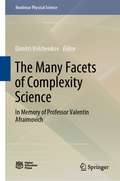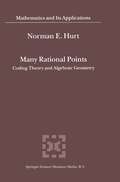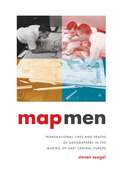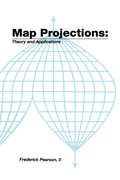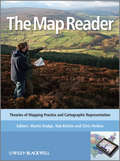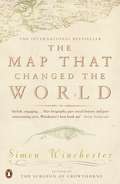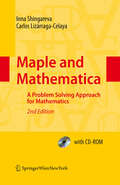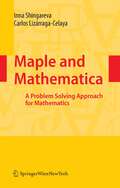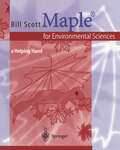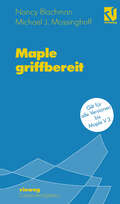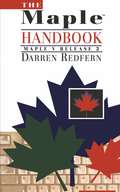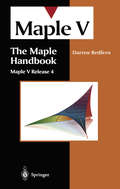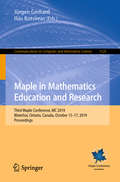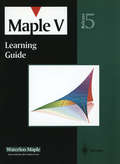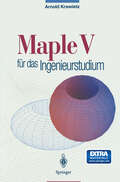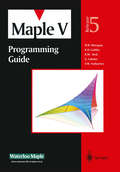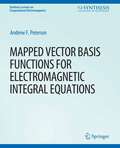- Table View
- List View
The Many Facets of Complexity Science: In Memory of Professor Valentin Afraimovich (Nonlinear Physical Science)
by Dimitri VolchenkovThis book explores recent developments in theoretical research and data analysis of real-world complex systems, organized in three parts, namely Entropy, information, and complexity functions Multistability, oscillations, and rhythmic synchronization Diffusions, rotation, and convection in fluids The collection of works devoted to the memory of Professor Valentin Afraimovich provides a deep insight into the recent developments in complexity science by introducing new concepts, methods, and applications in nonlinear dynamical systems covering physical problems and mathematical modelling relevant to economics, genetics, engineering vibrations, as well as classic problems in physics, fluid and climate dynamics, and urban dynamics. The book facilitates a better understanding of the mechanisms and phenomena in nonlinear dynamics and develops the corresponding mathematical theory to apply nonlinear design to practical engineering. It can be read by mathematicians, physicists, complex systems scientists, IT specialists, civil engineers, data scientists, and urban planners.
Many Layers of Ecocentrism: Revering Life, Revering the Earth
by Abhik GuptaThis book unveils the myriad streams of ecocentric thoughts that have been flowing through the human mind – in indigenous communities, in the wisdom of philosophers, in the creative expressions of poets and writers – sometimes latent, but sometimes more explicit. The strength of this book lies in the fact that it attempts to show that ecocentrism had not emerged suddenly as a distinct line of philosophical thought or found its place among the various normative approaches toward nature, but the seeds of ecocentrism had always been running through human societies. Thus, this book not only emphasizes the “unity of life” but also reveals the inherent unity of all hues of ecocentrism. The book adopts a multidisciplinary approach, which is essential to dwell on a topic like ecocentrism which permeates the domains of disciplines as disparate as science, philosophy, religion, normative ethics, myths and folklore, poetry, and literature, among others. Despite this eclectic approach, the book attempts to maintain continuity among the chapters and present these concepts in a simple form that will be easily accessible by readers from all conceivable backgrounds. This book would be useful to the students, researchers, and faculty from the fields of ecology and environmental science, philosophy, sociology, religious studies, and literature. It will also be an indispensable companion for all nature lovers, activists, and general readers interested in the emergence and evolution of environmental thoughts.
Many Layers of Ecocentrism: Revering Life, Revering the Earth
by Abhik GuptaThis book unveils the myriad streams of ecocentric thoughts that have been flowing through the human mind – in indigenous communities, in the wisdom of philosophers, in the creative expressions of poets and writers – sometimes latent, but sometimes more explicit. The strength of this book lies in the fact that it attempts to show that ecocentrism had not emerged suddenly as a distinct line of philosophical thought or found its place among the various normative approaches toward nature, but the seeds of ecocentrism had always been running through human societies. Thus, this book not only emphasizes the “unity of life” but also reveals the inherent unity of all hues of ecocentrism. The book adopts a multidisciplinary approach, which is essential to dwell on a topic like ecocentrism which permeates the domains of disciplines as disparate as science, philosophy, religion, normative ethics, myths and folklore, poetry, and literature, among others. Despite this eclectic approach, the book attempts to maintain continuity among the chapters and present these concepts in a simple form that will be easily accessible by readers from all conceivable backgrounds. This book would be useful to the students, researchers, and faculty from the fields of ecology and environmental science, philosophy, sociology, religious studies, and literature. It will also be an indispensable companion for all nature lovers, activists, and general readers interested in the emergence and evolution of environmental thoughts.
Many Rational Points: Coding Theory and Algebraic Geometry (Mathematics and Its Applications #564)
by N.E. HurtMap Men: Transnational Lives and Deaths of Geographers in the Making of East Central Europe
by Steven SeegelMore than just colorful clickbait or pragmatic city grids, maps are often deeply emotional tales: of political projects gone wrong, budding relationships that failed, and countries that vanished. In Map Men, Steven Seegel takes us through some of these historical dramas with a detailed look at the maps that made and unmade the world of East Central Europe through a long continuum of world war and revolution. As a collective biography of five prominent geographers between 1870 and 1950—Albrecht Penck, Eugeniusz Romer, Stepan Rudnyts’kyi, Isaiah Bowman, and Count Pál Teleki—Map Men reexamines the deep emotions, textures of friendship, and multigenerational sagas behind these influential maps. Taking us deep into cartographical archives, Seegel re-creates the public and private worlds of these five mapmakers, who interacted with and influenced one another even as they played key roles in defining and redefining borders, territories, nations—and, ultimately, the interconnection of the world through two world wars. Throughout, he examines the transnational nature of these processes and addresses weighty questions about the causes and consequences of the world wars, the rise of Nazism and Stalinism, and the reasons East Central Europe became the fault line of these world-changing developments. At a time when East Central Europe has surged back into geopolitical consciousness, Map Men offers a timely and important look at the historical origins of how the region was defined—and the key people who helped define it.
Map Men: Transnational Lives and Deaths of Geographers in the Making of East Central Europe
by Steven SeegelMore than just colorful clickbait or pragmatic city grids, maps are often deeply emotional tales: of political projects gone wrong, budding relationships that failed, and countries that vanished. In Map Men, Steven Seegel takes us through some of these historical dramas with a detailed look at the maps that made and unmade the world of East Central Europe through a long continuum of world war and revolution. As a collective biography of five prominent geographers between 1870 and 1950—Albrecht Penck, Eugeniusz Romer, Stepan Rudnyts’kyi, Isaiah Bowman, and Count Pál Teleki—Map Men reexamines the deep emotions, textures of friendship, and multigenerational sagas behind these influential maps. Taking us deep into cartographical archives, Seegel re-creates the public and private worlds of these five mapmakers, who interacted with and influenced one another even as they played key roles in defining and redefining borders, territories, nations—and, ultimately, the interconnection of the world through two world wars. Throughout, he examines the transnational nature of these processes and addresses weighty questions about the causes and consequences of the world wars, the rise of Nazism and Stalinism, and the reasons East Central Europe became the fault line of these world-changing developments. At a time when East Central Europe has surged back into geopolitical consciousness, Map Men offers a timely and important look at the historical origins of how the region was defined—and the key people who helped define it.
Map Men: Transnational Lives and Deaths of Geographers in the Making of East Central Europe
by Steven SeegelMore than just colorful clickbait or pragmatic city grids, maps are often deeply emotional tales: of political projects gone wrong, budding relationships that failed, and countries that vanished. In Map Men, Steven Seegel takes us through some of these historical dramas with a detailed look at the maps that made and unmade the world of East Central Europe through a long continuum of world war and revolution. As a collective biography of five prominent geographers between 1870 and 1950—Albrecht Penck, Eugeniusz Romer, Stepan Rudnyts’kyi, Isaiah Bowman, and Count Pál Teleki—Map Men reexamines the deep emotions, textures of friendship, and multigenerational sagas behind these influential maps. Taking us deep into cartographical archives, Seegel re-creates the public and private worlds of these five mapmakers, who interacted with and influenced one another even as they played key roles in defining and redefining borders, territories, nations—and, ultimately, the interconnection of the world through two world wars. Throughout, he examines the transnational nature of these processes and addresses weighty questions about the causes and consequences of the world wars, the rise of Nazism and Stalinism, and the reasons East Central Europe became the fault line of these world-changing developments. At a time when East Central Europe has surged back into geopolitical consciousness, Map Men offers a timely and important look at the historical origins of how the region was defined—and the key people who helped define it.
Map Men: Transnational Lives and Deaths of Geographers in the Making of East Central Europe
by Steven SeegelMore than just colorful clickbait or pragmatic city grids, maps are often deeply emotional tales: of political projects gone wrong, budding relationships that failed, and countries that vanished. In Map Men, Steven Seegel takes us through some of these historical dramas with a detailed look at the maps that made and unmade the world of East Central Europe through a long continuum of world war and revolution. As a collective biography of five prominent geographers between 1870 and 1950—Albrecht Penck, Eugeniusz Romer, Stepan Rudnyts’kyi, Isaiah Bowman, and Count Pál Teleki—Map Men reexamines the deep emotions, textures of friendship, and multigenerational sagas behind these influential maps. Taking us deep into cartographical archives, Seegel re-creates the public and private worlds of these five mapmakers, who interacted with and influenced one another even as they played key roles in defining and redefining borders, territories, nations—and, ultimately, the interconnection of the world through two world wars. Throughout, he examines the transnational nature of these processes and addresses weighty questions about the causes and consequences of the world wars, the rise of Nazism and Stalinism, and the reasons East Central Europe became the fault line of these world-changing developments. At a time when East Central Europe has surged back into geopolitical consciousness, Map Men offers a timely and important look at the historical origins of how the region was defined—and the key people who helped define it.
Map ProjectionsTheory and Applications
by II PearsonAbout the Author: Frederick Pearson has extensive experience in teaching map projection at the Air Force Cartography School and Virginia Polytechnic Institute. He developed star charts, satellite trajectory programs, and a celestial navigation device for the Aeronautical Chart and Information Center. He is an expert in orbital analysis of satellites, and control and guidance systems. At McDonnell-Douglas, he worked on the guidance system for the space shuttle.This text develops the plotting equations for the major map projections. The emphasis is on obtaining usable algorithms for computed aided plotting and CRT display. The problem of map projection is stated, and the basic terminology is introduced. The required fundamental mathematics is reviewed, and transformation theory is developed. Theories from differential geometry are particularized for the transformation from a sphere or spheroid as the model of the earth onto a selected plotting surface. The most current parameters to describe the figure of the earth are given. Formulas are included to calculate meridian length, parallel length, geodetic and geocentric latitude, azimuth, and distances on the sphere or spheroid. Equal area, conformal, and conventional projection transformations are derived. All result in direct transformation from geographic to cartesian coordinates. For selected projections, inverse transformations from cartesian to geographic coordinates are given. Since the avoidance of distortion is important, the theory of distortion is explored. Formulas are developed to give a quantitative estimate of linear, area, and angular distortions. Extended examples are given for several mapping problems of interest. Computer applications, and efficient algorithms are presented. This book is an appropriate text for a course in the mathematical aspects of mapping and cartography. Map projections are of interest to workers in many fields. Some of these are mathematicians, engineers, surveyors, geodi
Map ProjectionsTheory and Applications
by II PearsonAbout the Author: Frederick Pearson has extensive experience in teaching map projection at the Air Force Cartography School and Virginia Polytechnic Institute. He developed star charts, satellite trajectory programs, and a celestial navigation device for the Aeronautical Chart and Information Center. He is an expert in orbital analysis of satellites, and control and guidance systems. At McDonnell-Douglas, he worked on the guidance system for the space shuttle.This text develops the plotting equations for the major map projections. The emphasis is on obtaining usable algorithms for computed aided plotting and CRT display. The problem of map projection is stated, and the basic terminology is introduced. The required fundamental mathematics is reviewed, and transformation theory is developed. Theories from differential geometry are particularized for the transformation from a sphere or spheroid as the model of the earth onto a selected plotting surface. The most current parameters to describe the figure of the earth are given. Formulas are included to calculate meridian length, parallel length, geodetic and geocentric latitude, azimuth, and distances on the sphere or spheroid. Equal area, conformal, and conventional projection transformations are derived. All result in direct transformation from geographic to cartesian coordinates. For selected projections, inverse transformations from cartesian to geographic coordinates are given. Since the avoidance of distortion is important, the theory of distortion is explored. Formulas are developed to give a quantitative estimate of linear, area, and angular distortions. Extended examples are given for several mapping problems of interest. Computer applications, and efficient algorithms are presented. This book is an appropriate text for a course in the mathematical aspects of mapping and cartography. Map projections are of interest to workers in many fields. Some of these are mathematicians, engineers, surveyors, geodi
The Map Reader: Theories of Mapping Practice and Cartographic Representation
by Martin Dodge Rob Kitchin Chris PerkinsWINNER OF THE CANTEMIR PRIZE 2012 awarded by the Berendel Foundation The Map Reader brings together, for the first time, classic and hard-to-find articles on mapping. This book provides a wide-ranging and coherent edited compendium of key scholarly writing about the changing nature of cartography over the last half century. The editorial selection of fifty-four theoretical and thought provoking texts demonstrates how cartography works as a powerful representational form and explores how different mapping practices have been conceptualised in particular scholarly contexts. Themes covered include paradigms, politics, people, aesthetics and technology. Original interpretative essays set the literature into intellectual context within these themes. Excerpts are drawn from leading scholars and researchers in a range of cognate fields including: Cartography, Geography, Anthropology, Architecture, Engineering, Computer Science and Graphic Design. The Map Reader provides a new unique single source reference to the essential literature in the cartographic field: more than fifty specially edited excerpts from key, classic articles and monographs critical introductions by experienced experts in the field focused coverage of key mapping practices, techniques and ideas a valuable resource suited to a broad spectrum of researchers and students working in cartography and GIScience, geography, the social sciences, media studies, and visual arts full page colour illustrations of significant maps as provocative visual ‘think-pieces’ fully indexed, clearly structured and accessible ways into a fast changing field of cartographic research
The Map Reader: Theories of Mapping Practice and Cartographic Representation
by The Map ReaderWINNER OF THE CANTEMIR PRIZE 2012 awarded by the Berendel Foundation The Map Reader brings together, for the first time, classic and hard-to-find articles on mapping. This book provides a wide-ranging and coherent edited compendium of key scholarly writing about the changing nature of cartography over the last half century. The editorial selection of fifty-four theoretical and thought provoking texts demonstrates how cartography works as a powerful representational form and explores how different mapping practices have been conceptualised in particular scholarly contexts. Themes covered include paradigms, politics, people, aesthetics and technology. Original interpretative essays set the literature into intellectual context within these themes. Excerpts are drawn from leading scholars and researchers in a range of cognate fields including: Cartography, Geography, Anthropology, Architecture, Engineering, Computer Science and Graphic Design. The Map Reader provides a new unique single source reference to the essential literature in the cartographic field: more than fifty specially edited excerpts from key, classic articles and monographs critical introductions by experienced experts in the field focused coverage of key mapping practices, techniques and ideas a valuable resource suited to a broad spectrum of researchers and students working in cartography and GIScience, geography, the social sciences, media studies, and visual arts full page colour illustrations of significant maps as provocative visual ‘think-pieces’ fully indexed, clearly structured and accessible ways into a fast changing field of cartographic research
The Map That Changed the World: A Tale of Rocks, Ruin and Redemption (Wheeler Large Print Book Ser.)
by Simon WinchesterThe extraordinary tale of the father of modern geology. Hidden behind velvet curtains above a stairway in a house in London's Piccadilly is an enormous and beautiful hand-coloured map - the first geological map of anywhere in the world. Its maker was a farmer's son named William Smith. Born in 1769 his life was beset by troubles: he was imprisoned for debt, turned out of his home, his work was plagiarised, his wife went insane and the scientific establishment shunned him. It was not until 1829, when a Yorkshire aristocrat recognised his genius, that he was returned to London in triumph: The Map That Changed the World is his story.
Maple and Mathematica: A Problem Solving Approach for Mathematics
by Inna K. Shingareva Carlos Lizárraga-CelayaIn the history of mathematics there are many situations in which cal- lations were performed incorrectly for important practical applications. Let us look at some examples, the history of computing the number ? began in Egypt and Babylon about 2000 years BC, since then many mathematicians have calculated ? (e. g. , Archimedes, Ptolemy, Vi` ete, etc. ). The ?rst formula for computing decimal digits of ? was disc- ered by J. Machin (in 1706), who was the ?rst to correctly compute 100 digits of ?. Then many people used his method, e. g. , W. Shanks calculated ? with 707 digits (within 15 years), although due to mistakes only the ?rst 527 were correct. For the next examples, we can mention the history of computing the ?ne-structure constant ? (that was ?rst discovered by A. Sommerfeld), and the mathematical tables, exact - lutions, and formulas, published in many mathematical textbooks, were not veri?ed rigorously [25]. These errors could have a large e?ect on results obtained by engineers. But sometimes, the solution of such problems required such techn- ogy that was not available at that time. In modern mathematics there exist computers that can perform various mathematical operations for which humans are incapable. Therefore the computers can be used to verify the results obtained by humans, to discovery new results, to - provetheresultsthatahumancanobtainwithoutanytechnology. With respectto our example of computing?, we can mention that recently (in 2002) Y. Kanada, Y. Ushiro, H. Kuroda, and M.
Maple and Mathematica: A Problem Solving Approach for Mathematics
by Inna K. Shingareva Carlos Lizárraga-CelayaBy presenting side-by-side comparisons, this handbook enables Mathematica users to quickly learn Maple, and vice versa. The parallel presentation enables students, mathematicians, scientists, and engineers to easily find equivalent functions on each of these algebra programs. The handbook provides core material for incorporating Maple and Mathematica as working tools into many different undergraduate mathematics courses.
Maple® for Environmental Sciences: a Helping Hand
by Bill ScottA presentation of what Maple can do and how it does it in the context of environmental sciences. The text includes introductory tutorials in each chapter combined with extensive marginal comments which are followed by a complete application. These include the contouring of water table data, the physical chemistry of kidney stones, and acid rain. The book also provides a special application to enable students to use "self help" in the case that Maple seem unable to do the simplest things.
Maple griffbereit: Alle Versionen bis Maple V 3
by Nancy Blachman Michael J. MossinghoffIn diesem Buch finden Sie alles, was Sie als Maple-Anwender wissen müssen: Als Neueinsteiger finden Sie eine ausführliche Einführung in die Fähigkeiten des Systems. Als versierter Benutzer können Sie die genaue Bedeutung der verschiedenen Parameter und Optionen für einen bestimmten Befehl nachschauen. Und als "Quereinsteiger" mit Mathematica-Kenntnissen können Sie nachschauen, wie die ihm bekannten Befehle in Maple heißen. Sämtliche Befehle aller Maple-Versionen bis Maple V 3 sind hier sowohl systematisch als auch alphabetisch aufgelistet und erklärt, Bezugs- und Informationsquellen sowie ein Glossar runden das Werk ab, das neben jedem Maple-Rechner liegen sollte.
The Maple Handbook: Maple V Release 3
by Darren RedfernHow to Use This Handbook The Maple Handbook is a complete reference tool for the Maple language, and is written for all Maple users, regardless of their dis cipline or field(s) of interest. All the built-in mathematical, graphic, and system-based commands available in Maple V Release 3 are detailed herein. Please note that The Maple Handbook does not teach about the mathematics behind Maple commands. If you do not know the meaning of such concepts as definite integral, identity matrix, or prime integer, do not expect to learn them here. As well, while the introductory sections to each chapter taken together do provide a basic overview of the capabilities of Maple, it is highly recom mended that you also read a more thorough tutorial such as In troduction to Maple by Andre Heck or First Leaves: A Tutorial Introduction to Maple V. Overall Organization One of the main premises of The Maple Handbook is that most Maple users approach the system to solve a particular problem (or set of problems) in a specific subject area. Therefore, all commands are organized in logical subsets that reflect these different cate gories (e.g., calculus, algebra, data manipulation, etc.) and the com mands within a subset are explained in a similar language, creating a tool that allows you quick and confident access to the information necessary to complete the problem you have brought to the system.
The Maple Handbook: Maple V Release 4
by Darren RedfernAn essential reference tool for all users of the Maple system, providing a complete listing of every command in the Maple language, categorised into logical categories and explained in this context. A short, introductory tutorial starts the Handbook, and each category begins with a brief introduction to the related subject area. It is well referenced, with an alphabetical index of commands, and pointers to appropriate sections of the official Maple documentation. This new approach to reference material enhances that found in Maples on-line help files and provides a much more organised, intuitive resource for all users of the system. The Handbook improves efficiency by supplying users with the information they need - at their fingertips. This new edition covers the Maple V Release 4 symbolic computation language.
Maple in Mathematics Education and Research: Third Maple Conference, MC 2019, Waterloo, Ontario, Canada, October 15–17, 2019, Proceedings (Communications in Computer and Information Science #1125)
by Jürgen Gerhard Ilias KotsireasThis book constitutes the refereed proceedings of the third Maple Conference, MC 2019, held in Waterloo, Ontario, Canada, in October 2019. The 21 revised full papers and 9 short papers were carefully reviewed and selected out of 37 submissions, one invited paper is also presented in the volume. The papers included in this book cover topics in education, algorithms, and applciations of the mathematical software Maple.
Maple V: Learning Guide
by Waterloo Maple IncorporatedMaple V Mathematics Learning Guide is the fully revised introductory documentation for Maple V Release 5. It shows how to use Maple V as a calculator with instant access to hundreds of high-level math routines and as a programming language for more demanding or specialized tasks. Topics include the basic data types and statements in the Maple V language. The book serves as a tutorial introduction and explains the difference between numeric computation and symbolic computation, illustrating how both are used in Maple V Release 5. Extensive "how-to" examples are presented throughout the text to show how common types of calculations can be easily expressed in Maple. Graphics examples are used to illustrate the way in which 2D and 3D graphics can aid in understanding the behaviour of problems.
Maple V für das Ingenieurstudium
by Arnold KrawietzDieses Buch zeigt dem Ingenieurstudenten - und dem in der Praxis tätigen Ingenieur - die für ihn wichtigen Einsatzmöglichkeiten der Computeralgebra und weist auf geeignete mathematische Formulierungen hin. Das geschieht anhand von Fragestellungen aus den Grundlagenfächern (Höhere Mathematik, Technische Mechanik, Physikalisches Praktikum, Elemente des Programmierens), für die der Leser auf diese Weise zugleich ein vertieftes Verständnis gewinnt.
Maple V Programming Guide: for Release 5
by Waterloo Maple IncorporatedMaple V Mathematics Programming Guide is the fully updated language and programming reference for Maple V Release 5. It presents a detailed description of Maple V Release 5 - the latest release of the powerful, interactive computer algebra system used worldwide as a tool for problem-solving in mathematics, the sciences, engineering, and education. This manual describes the use of both numeric and symbolic expressions, the data types available, and the programming language statements in Maple. It shows how the system can be extended or customized through user defined routines and gives complete descriptions of the system's user interface and 2D and 3D graphics capabilities.
Mapmatics: How We Navigate the World Through Numbers
by Paulina Rowinska'An expansive journey through time and place' - The Observer'An adventure' - Edward Brooke-Hitching, author of The Phantom AtlasHow does a delivery driver distribute hundreds of packages in a single working day?Why does remote Alaska have such a large airport?Where should we look for elusive serial killers?The answers lie in the crucial connection between maps and maths.In Mapmatics, Dr Paulina Rowinska embarks on a fascinating journey to discover the mathematical foundations of cartography and cartographical influences on mathematics.From a sixteenth-century map that remains an indispensable navigation tool despite emphasizing the North–South divide to public transport maps that both guide and mislead passengers, she reveals how maps and maths shape not only our sense of space and time but also our worldview.Through entertaining stories, surprising real-world examples and a cast of unforgettable characters, Mapmatics helps us to appreciate the mathematical methods and ideas behind maps. And, by illuminating how our world works, leaves us better equipped to understand and look after it.
Mapped Vector Basis Functions for Electromagnetic Integral Equations (Synthesis Lectures on Computational Electromagnetics)
by Andrew PetersonThe method-of-moments solution of the electric field and magnetic field integral equations (EFIE and MFIE) is extended to conducting objects modeled with curved cells. These techniques are important for electromagnetic scattering, antenna, radar signature, and wireless communication applications. Vector basis functions of the divergence-conforming and curl-conforming types are explained, and specific interpolatory and hierarchical basis functions are reviewed. Procedures for mapping these basis functions from a reference domain to a curved cell, while preserving the desired continuity properties on curved cells, are discussed in detail. For illustration, results are presented for examples that employ divergence-conforming basis functions with the EFIE and curl-conforming basis functions with the MFIE. The intended audience includes electromagnetic engineers with some previous familiarity with numerical techniques.
